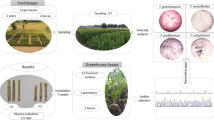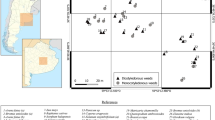Abstract
In order to investigate the pre-harvest contamination of maize plants by Fusarium species in Belgium, a three-year survey has been performed in five fields in which three hybrids differing in susceptibility to maize stalk rot were sampled at four different physiological stages. An extensive collection of 5,659 Fusarium isolates characterized at the species level was established during the 2005, 2006, and 2007 growing seasons, with a total of 23 different Fusarium species identified to occur on ears and stalks. A high number of plants was already contaminated by Fusarium spp. at the anthesis stage, although no symptoms were visible on ears or on stalks. As the season progressed, the incidence of Fusarium-infected maize plants reached 100% in several fields. At the end of the growing season, the most frequently isolated species in maize ears were F. graminearum, sometimes associated with F. avenaceum, F. crookwellense, F. culmorum, F. poae, and F. temperatum, a new species recently described on maize. The predominant Fusarium species detected in stalks at the end of the growing season were F. graminearum and F. crookwellense, often associated with F. culmorum and F. temperatum. Year-to-year variability observed for the incidence of F. graminearum can most likely be associated with differences in climatic conditions among the three years.



Similar content being viewed by others
References
Anonymous (2010). Chiffres-clés agriculture 2010. (Brussels: SPF Economie, Direction générale Statistique et Information économique).
Bottalico, A. (1998). Fusarium diseases of cereals: species complex and related mycotoxin profiles, in Europe. Journal of Plant Pathology, 80, 85–103.
Brygoo, Y., & Gautier, A. (2007). Molecular polymorphism of Fusarium strains isolated from wheat and corn ears in France Collects 2003 and 2004. (Paper presented at the conférence sur les progrès et perspectives de la recherche sur les mycotoxines de Fusarium dans les céréales. Arcachon, France)
Carter, J. P., Rezanoor, H. N., Holden, D., Desjardins, A. E., Plattner, R. D., & Nicholson, P. (2002). Variation in pathogenicity associated with the genetic diversity of Fusarium graminearum. European Journal of Plant Pathology, 108, 573–583.
Charmley, L. L., Trenholm, H. L., Prelusky, D. A., & Rosenberg, A. (1995). Economic losses and decontamination. Natural Toxins, 3, 199–203.
Chu, F. S., & Li, G. Y. (1994). Simultaneous occurrence of fumonisin B1 and other mycotoxins in moldy corn collected from the People’s Republic of China in regions with high incidences of esophageal cancer. Applied and Environmental Microbiology, 60, 847–852.
Cotten, T. K., & Munkvold, G. P. (1998). Survival of Fusarium moniliforme, F. proliferatum, and F. subglutinans in maize stalk residue. Phytopathology, 88, 550–555.
Desjardins, A. E. (2006). Fusarium mycotoxins: chemistry, genetics and biology. Saint Paul: APS.
di Menna, M. E., Lauren, D. R., & Hardacre, A. (1997). Fusaria and Fusarium toxins in New Zealand maize plants. Mycopathologia, 139, 165–173.
Doohan, F. M., Brennan, J., & Cooke, B. M. (2003). Influence of climatic factors on Fusarium species pathogenic to cereals. European Journal of Plant Pathology, 109, 755–768.
Dorn, B., Forrer, H. R., Schürch, S., & Vogelgsang, S. (2009). Fusarium species complex on maize in Switzerland: occurrence, prevalence, impact and mycotoxins in commercial hybrids under natural infection. European Journal of Plant Pathology, 125, 51–61.
Goertz, A., Oerke, E. C., Steiner, U., Wallwijk, C., de Vriees, I., & Dehne, H. W. (2008). Biodiversity of Fusarium species causing ear rot in Germany. (Paper presented at the 3 rd International Fusarium Head Blight Symposium, Szeged, Hungary), suppl.B.51, 617–621.
Hoenisch, R. W., & Davis, R. L. M. (1994). Relationship between kernel pericarp thickness and susceptibility to fusarium ear rot in field corn. Plant Disease, 78, 517–519.
Kedera, C. W., Leslie, J. F., & Claflin, L. E. (1994). Genetic diversity of Fusarium section Liseola (Gibberella fujikuroi) in individual maize stalks. Phytopathology, 84, 603–607.
Kommedahl, T., Windels, C. E., & Stucker, R. E. (1979). Occurrence of Fusarium species in roots and stalks of symptomless corn plants during the growing season. Phytopathology, 69, 961–966.
Leslie, J. F., & Summerell, B. A. (2006). The fusarium laboratory manual. Ames: Blackwell.
Lew, H., Adler, A., & Edinger, W. (1997). Dynamics of the Fusarium toxin distribution in maize plants affected by stalk rot. Cereal Research Communications, 25, 467–470.
Logrieco, A., Mulè, G., Moretti, A., & Bottalico, A. (2002). Toxigenic Fusarium species and mycotoxins associated with maize ear rot in Europe. European Journal of Plant Pathology, 108, 597–609.
Maiorano, A., Blandino, M., Reyneri, A., & Vanara, F. (2008). Effects of maize residues on the Fusarium spp. infection and deoxynivalenol (DON) contamination of wheat grain. Crop Protection, 27, 182–188.
Munkvold, G. P. (2003a). Cultural and genetic approaches to managing mycotoxins in maize. Annual Review of Phytopathology, 41, 99–116.
Munkvold, G. P. (2003b). Epidemiology of Fusarium diseases and their mycotoxins in maize ears. European Journal of Plant Pathology, 109, 705–713.
Munkvold, G. P., McGee, D. C., & Carlton, W. M. (1997). Importance of different pathways for maize kernel infection by Fusarium moniliforme. Phytopathology, 87, 209–217.
Nelson, P. E., Toussoun, T. A., & Marasas, W. F. O. (1983). Fusarium species: an illustrated manual for identification. University Park: Pennsylvania State University Press.
O’Donnell, K., Kistler, H. C., Cigelnik, E., & Ploetz, R. C. (1998). Multiple evolutionary origins of the fungus causing Panama disease of banana: concordant evidence from nuclear and mitochondrial gene genealogies. Proceedings of the National Academy of Sciences of the United States of America, 95, 2044–2049.
Ramirez, M. L., Pascale, M., Chulze, S., Reynoso, M. M., March, G., & Visconti, A. (1996). Natural occurrence of fumonisins and their correlation to Fusarium contamination in commercial corn hybrids growth in Argentina. Mycopathologia, 135, 29–34.
Reid, L. M., Nicol, R. W., Ouellet, T., Savard, M., Miller, J. D., Young, J. C., et al. (1999). Interaction of Fusarium graminearum and F. moniliforme in maize ears: disease progress, fungal biomass, and mycotoxin accumulation. Phytopathology, 89, 1028–1037.
Renard, F., Mary, M., Foucart, G., Mazy, J. P., Vandeputte, F., Blondiau, F., et al. (2007). Résultats des essais comparatifs de variétés de maïs fourrage et grain, année culturale 2006/2007. Louvain-la-Neuve: Centre Indépendant de Promotion Fourragère.
Ritchie, S. W., & Hanway, J. J. (1982). How a corn plant develops. (Ames: Special Report 48).
Scauflaire, J., Gourgue, M., & Munaut, F. (2010). Fusarium temperatum sp. nov. from maize, an emergent species closely related to Fusarium subglutinans. Mycologia (in press). doi: 10.3852/10-135.
Sutton, J. C. (1982). Epidemiology of wheat head blight and maize ear rot caused by Fusarium graminearum. Canadian Journal of Plant Pathology, 4, 195–209.
Vigier, B., Reid, L. M., Seifert, K. A., Stewart, D. W., & Hamilton, R. I. (1997). Distribution and prediction of Fusarium species associated with maize ear rot in Ontario. Canadian Journal of Plant Pathology, 19, 60–65.
Wagacha, J. M., & Muthomi, J. W. (2007). Fusarium culmorum: Infection process, mechanisms of mycotoxin production and their role in pathogenesis in wheat. Crop Protection, 26, 877–885.
Warfield, C. Y., & Davis, R. M. (1996). Importance of the husk covering on the susceptibility of corn hybrids to Fusarium ear rot. Plant Disease, 80, 208–210.
White, G. D. (2000). Compendium of corn diseases, third edition. Saint Paul: APS.
Wilson, T. M., Ross, P. F., Rice, L. G., Osweiler, G. D., Nelson, H. A., Owens, D. L., et al. (1990). Fumonisin B1 levels associated with an epizootic of equine leukoencephalomalacia. Journal of Veterinary Diagnostic Investigation, 2, 213–216.
Xu, X. (2003). Effects of environmental conditions on the development of Fusarium ear blight. European Journal of Plant Pathology, 109, 683–689.
Acknowledgments
This research was founded by the Direction Générale de l’Agriculture, Direction de la Recherche, ref. 1217, in the framework of the project Caractérisation et dynamique des fusarioses sur maïs en Région Wallonne. We thank the CIPF and the CARAH for providing the fields for the research and for scientific and technical assistance. We are grateful to the Mycothèque de l’Université catholique de Louvain (BCCM™/MUCL) for scientific support.
Author information
Authors and Affiliations
Corresponding author
Rights and permissions
About this article
Cite this article
Scauflaire, J., Mahieu, O., Louvieaux, J. et al. Biodiversity of Fusarium species in ears and stalks of maize plants in Belgium. Eur J Plant Pathol 131, 59–66 (2011). https://doi.org/10.1007/s10658-011-9787-1
Accepted:
Published:
Issue Date:
DOI: https://doi.org/10.1007/s10658-011-9787-1




